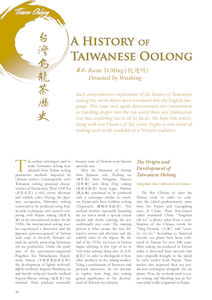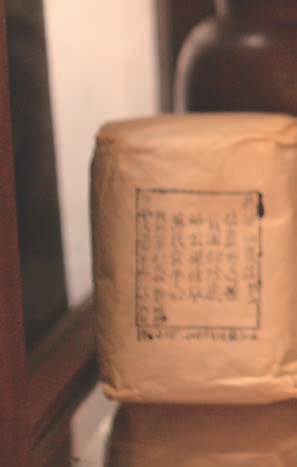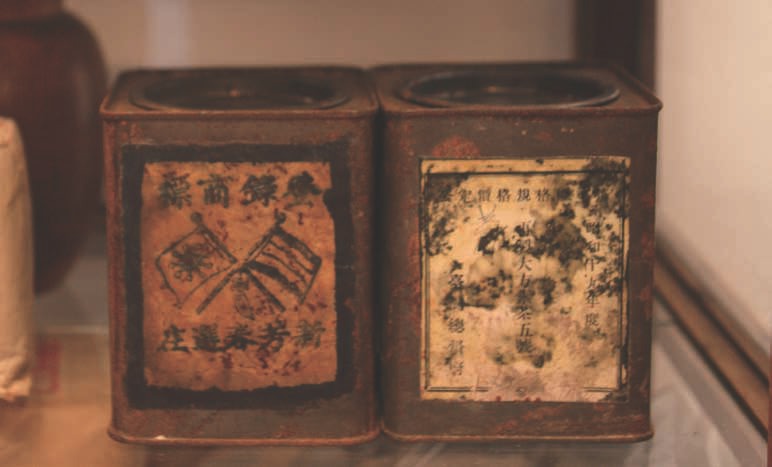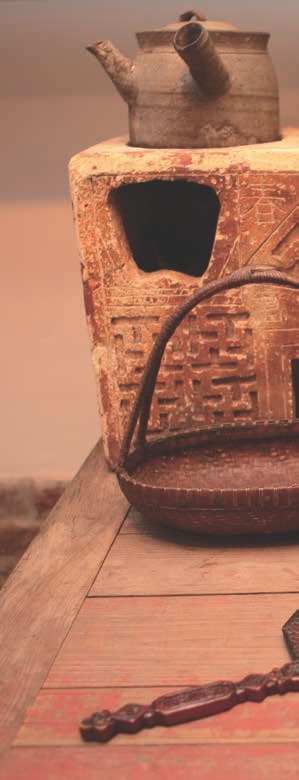
 |
|
The earliest techniques used to make Taiwanese oolong were adopted from Fujian oolong production methods imported by Chinese settlers. Consequently, early Taiwanese oolong possessed characteristics of Fujian-style Wuyi Cliff Tea (武夷岩茶): a rich, savory aftertaste and reddish color. During the Japanese occupation, Taiwanese oolong continued to be produced using Fujian-style techniques and started competing with Fujian oolong (福州烏 龍) in the international market. In the 1920s, the international oolong market experienced a downturn and the Japanese governor-general of Taiwan took steps to diversify Taiwan's tea trade by actively promoting Taiwanese red tea production. Under the guidance of the government-supported Pingzhen Tea Manufacture Experiment Station (平鎮茶業試驗支所), the development of lightly withered, lightly oxidized, fragrant Baozhong tea and heavily withered, heavily oxidized Eastern Beauty oolong (椪風茶) was initiated. These products eventually became some of Taiwan's most famous specialty teas.
After the liberation of Taiwan from Japanese rule, Puzhong tea (埔中茶) from Mingjian, Nantou (名間鄉) and Dong Ding oolong (凍頂烏龍茶) from Lugu, Nantou (鹿谷鄉) continued to be produced with a technique similar to southern Fujian-style Iron Goddess oolong (Tieguanyin, 鐵觀音烏龍茶). This method involves repeatedly kneading the tea leaves inside a special cotton satchel and slowly roasting the tea, traditionally over coals. The roasting process is what creates the tea's distinctive aroma and aftertaste and the reddish color of the liquor. By the end of the 1970s, tea lovers in Taiwan began referring to this type of tea as "red water oolong (hong shui, 紅水烏 龍茶)" in order to distinguish it from other products in the oolong market. Using a combination of literature and personal experience, we can attempt to explain how hong shui oolong gained significance in the development of Taiwan's tea industry.
The first Chinese to cross the Taiwan strait in order to cultivate the island predominately came from the Fujian and Guangdong areas of China. These first-comers called mainland China "Tangshan (唐山)," a phrase taken from a combination of the Chinese words for "Tang Dynasty (大唐)" and "country (江山)." According to historical records, tea plants have been cultivated in Taiwan for over 200 years. Most oolong tea produced in Taiwan today is harvested from varietals that were originally brought to the island by early settlers from Fujian. These settlers also imported their tea production techniques alongside the tea plants. Thus, the methods used to create oolong and Baozhong teas in Taiwan today really originated in Fujian.

In History of the Development of Taiwan, author Daxue Cheng states, "In the 23rd year of Emperor Kangxi's reign (1684 C.E.), settlers from Guangdong province began arriving in Yingge Stone Village (modern day Yingge Township (鶯歌鄉) in southern Taipei County) to cultivate and develop the land. After an armed conflict between settlers from Fujian (the Hoklo) and Guangdong (the Hakka), the Hakka were removed and the Hoklo were permitted to cultivate tea in Chashan." If Cheng's account is true, it can be inferred that Taiwanese tea cultivation began during the reign of Emperor Qianlong (1711 - 1799 C.E.), which is when the armed conflict between the Fujian and Guangdong peoples is recorded to have occurred.
Su Wen Ta's (蘇文達) A Brief History of Dong Ding Oolong posits, "Su Dong Ding's family genealogy, recorded in their Su family ancestral records, began with two Su nephews who crossed the strait to Taiwan during the Kangxi period. Su Tan (蘇坦) guided the development of Dong Ding Mountain until his son, Su Quan (蘇泉), began cultivating the tea plants growing on the mountain. Their children and grandchildren continued living in Dong Ding, earnestly manufacturing tea and farming new ground on Dong Ding Mountain. Their descendants Su Hui and Su Ru, as father and son, decided to completely leave the ancient farms and gardens to buy and sell contracts (leaving behind their moderately established, century-old location)." According to the above, the Su family also estimated that Dong Ding oolong was originally cultivated during the years of Emperor Qianlong's reign.
Another generally cited source is Heng Liang's (連橫) chronicling in General History of Taiwan: "During the reign of Emperor Jiaqing (17601820 C.E.), a man named Chao Ke (柯朝) brought Wuyi (武夷) tea plants from Fujian into Taiwan and planted them in Jieyukeng (傑魚坑), where they matured extremely well." W. H. Ukers, who authored All About Tea in 1935, believed tea cultivation in northern Taiwan began in the fifteenth year of Emperor Jiaqing's reign (1810 C.E.). Chinese settlers from Wuyi mountain in Fujian began to sow tea seeds in Jieyukeng (modern-day Ruifang District (台北縣瑞芳地區) in Taipei County); others interpret this area to have extended from the Shiding (石碇) maple forest to the Tuku area of Shenkeng (深坑土庫地區) in New Taipei City.
In northern Taiwan, tea plantations developed along the Danshui River basin and the tributaries of Xindian Creek, Keelung River, and Dakekan Creek (now called Dahan Creek (大漢溪) of Hsinchu and Taoyuan counties). The land developed for tea cultivation comprised modern-day New Taipei City (formerly Taipei County) and Taoyuan City (formerly Taoyuan County) and expanded out to Yilan County, Hsinchu County, and Miaoli County. Expanses of high elevation cannot be found in the topography stretching from Yilan to Hualian, over to Miaoli and down to Taichung in central Taiwan. Consequently, during both the Qing Dynasty and subsequent Japanese occupation, the government categorized the cities of Taipei, Taoyuan, Hsinchu, Miaoli, and Yilan into the same tea district. It was understood that the entire tea district used identical tea production techniques and cultivated tea belonging to the same Wuyi Cliff Tea varietals/cultivars. Peng Feng tea (椪風茶, also referred to as "Eastern Beauty, 東方美人" or "white tip oolong, (Bai Hao, 白毫)" was later initiated in this area, eventually turning into the renowned specialty teas of Ermei (峨眉) and Beipu (北埔), Hsinchu and Toufen (頭份), as well as Miaoli. This masterfully crafted tea was transformed from Wuyi Cliff Tea (the original oolong tea) into a new tea of its own.
Another important birthplace of Taiwanese tea developed along the Choshui River valley. The craftsmanship of Song Bai Keng tea (commonly referred to as Puzhong tea (埔中茶) back in the day) from Mingjian, Nantou and Dong Ding oolong (凍頂烏龍茶), manufactured in Lugu, Nantou was derived from south Fujian-style oolong, which is very different from north Fujian's Wuyi Cliff Tea. The use of a special cloth sack roller (布球揉捻) (also called a wrapped cloth roller (包布揉) by some tea makers), a rolling cloth sack (揉布球), and a ball rolling machine (團揉) during the manufacturing process is what creates Dong Ding oolong's distinctive fragrance and partially balled shape. The craftsmanship of neighboring Zhushan township's Shan Lin Xi high-mountain oolong (衫林溪 高山烏龍茶) also originated from this manufacturing process. Besides the aforementioned Danshui River tributary system, Lugu's Dong Ding mountain also had an important and far-reaching influence on the Taiwanese tea industry, yet its tea appears to have its origins in Tieguanyin oolong (鐵觀音烏龍茶) from Jhanghu Mountain in Muzha, Taipei, and Harbor tea (gan kou cha, 港口茶) in Manchou, Pingtung.
Muzha's Iron Goddess oolong (Muzha Tieguanyin, 木柵鐵觀音烏 龍茶) originated from Iron Goddess oolong in Anxi, Fujian. During the final years of the Qing Dynasty (when Japan occupied Taiwan), Iron Goddess tea was brought to Taipei by tea master Zhang Nai Miao. His hard work, perseverance, and zeal built the reputation of Muzha Iron Goddess oolong (Tieguanyin). The secrets of this magical tea varietal and the art of its cultivation were then passed down to locals in Muzha. Later, the Zhang Nai Miao Memorial Hall was established to commemorate his contribution to the development of Muzha's Iron Goddess oolong.

In the first year of the Qing Emperor Guangxu (1875 C.E.), the county of Hengchun, Pingtung, appointed its first county magistrate, Zhou Youji (周有基). Zhou's affinity for tea and support for its cultivation in Hengchun facilitated the planting of tea in southern Taiwan. In 1894, Hengchun county records state, "Luo Foshan tea (羅佛山茶): Thirty kilometers northeast of the county seat, there are towering mountains and precipitous ranges. The county magistrate, Zhou Youji, purchased tea seeds and taught the local people how to cultivate the plants... Their tea tasted very pure and had a red color... Every year their tea production amounted to less than five kilograms." The county records also say: "Harbor tea (港口茶): Twenty kilometers east of the county, a place named Linhai (臨海) also produces a small amount of tea that is similar to Luo Foshan tea in color, fragrance and taste."
I first witnessed the traditional production techniques used to create Manzhou, Pingtung's Harbor tea, in 1973. Produced purely and simply by hand, the tea is curled, rolled and dried from within the same tea wok. The tea wok kneading process necessitates an exacting technique, giving the tea leaves their green-gray luster, tightly knotted cord-like shape, and an upward bend which resembles an eyebrow. With an outward appearance almost analogous to Chinese Eyebrow tea (mei cha, 眉茶), we can speculate that Harbor tea's craftsmanship originated in the Zhejiang region of China using the same production techniques as Chinese Eyebrow tea. Although the production of Harbor tea gradually became mechanized after the 1970s, it still retains its gray-green luster and its characteristic cold, raw taste, like a densely concentrated pure white frost. Harbor tea plantations, though small, still retain a special status in Taiwan.
In the early 19th century, Chinese from Fujian and Guangdong gradually began expanding the cultivation of tea in northern Taiwan. By the 1850s, the northern Taiwan tea plantations that followed the hilly terrain of Danshui River and its tributaries were everywhere. At that time, much of Taiwanese tea was coarsely manufactured on the island before it was transported to Xiamen, Fuzhou, and other places, mainland China to be refined (sorted, blended, roasted) for sale and exported under the name "Fuzhou oolong (福州烏龍)."
In 1860, the Taiwanese port cities of Anping and Danshui opened for trade with foreign nations and foreign businessmen leapt at the opportunity. In 1861, Robert Swinhoe, stationed at the English consulate in Taiwan, was the first to point out the excellent quality of Taiwanese tea, the close proximity of tea mountains to the port of Danshui, and the potential for developing a tea trade. In 1864, the Englishman John Dodd went to Taiwan to investigate the potential for investment in camphor trees along the Danshui River. During his inspection, Dodd realized that the Danshui River basin was more suitable for growing tea. In 1865, he encouraged local farmers to produce tea, and in 1866, he established Dodd & Co. With the assistance of a man from Xiamen, Li Chensheng (李春生), Dodd acquired Taiwanese tea to promote his new tea enterprise.
In 1867, Dodd transported Taiwanese tea to Xiamen to be finished (roasted, sorted and packaged) and successfully distributed and sold the refined tea in Macao. In 1868, Dodd established a tea facility in what is the present day Wanhua district of Taipei. Aside from the tea transported to Xiamen and Fuzhou for refinement and export, Taiwanese tea also began to be sold directly to the United States in 1869, initiating the "Formosa tea (福爾摩沙茶)" and "Foochow tea (福州茶)" markets. Since then, "Formosa tea" also started being called "Taiwanese oolong," becoming internationally renowned for its excellent quality and distinct flavor. Consequently, British and American businessmen began coming to Taiwan one after another to participate in the growing Taiwanese oolong trade. By 1872, five Western companies - Dodd & Co. (寶順洋行), Tait (德記洋行), Boyd & Co. (和記洋行), Brown & Co. (水陸洋行) and Ellis & Co. (愛利士洋行) - successively arrived to set up offices in Taiwan.
Taiwanese oolong manufacturing methods during Japanese rule followed the production methods used under Qing Dynasty rule, except the production was made more scientific by the replacement of manual labor with machines, which increased output. For example, when using sun withering to reduce the moisture content in tea leaves, a 10% water loss rate is appropriate (i.e., the weight of the raw leaves is reduced by 10%).
In the year 1905, the research and development of tea processing machinery was initiated, and by 1912, its use was popularized, ultimately replacing manual shaking during indoor withering. In 1911, the Japanese introduced the oolong tea rolling machine (望月式揉捻機) to replace what they saw as an "unhygienic" practice of using the feet to knead the tea leaves. In 1912, the use of a machine to break up clumps of rolled tea (解塊機) was popularized and in 1915, the field-side pan-fire drum (田邊式釜炒機) was invented, replacing the manual pan-firing of tea leaves in woks. In 1927, the use of the Type II Drier (乙種乾 燥機) became widespread as well. The complete mechanization of oolong production resulted in a number of processing changes that standardized oolong production, but at the cost of traditional craftsmanship. The tea leaves experienced a more prolonged withering period, a reduction of shaking, and an efficient drying without simultaneous water accumulation and moderate oxidation. These processes maintained the fundamental elements of Fujian-style Wuyi Cliff Tea, producing the characteristic green leaves inlaid with red veins. The increase in efficiency meant that in 1915 12,000 metric tons of Taiwanese oolong were exported for the commencement of sales on the international market.
In 1920, Taiwanese oolong export sales fell by more than half of their original volume. This development prompted the international tea market to turn its attention toward red teas. The Ping Zhen Tea Manufacture Experiment Station responded to the trend of the times accordingly. The Station contrived the heavy withering and heavy oxidation processes which created the gorgeous color, aroma and taste of Eastern Beauty (Peng Feng).
This amazing tea is sun withered until a 15 - 35% rate of water loss occurs, almost double the 10 - 15% rate of water loss in Fujian-style oolong. The front end of the indoor withering and tossing process employs light tossing and a prolonged withering time, eliminating excess water in the tea leaves and creating ideal conditions under which the leaves can be evenly dried. The color of the tea gradually deepens to green-gray and the leaves give off a unique fragrance. In the final processing stage, the tea leaves are more vigorously tossed, inducing a higher oxidation level. After three to seven minutes of tossing, the leaves shimmer in both fresh green and gorgeous red tints respectively; different from Fujian-style oolong's green leaves inlaid with red veins.
After pan-firing, a distinctive process takes place in which the leaves are placed inside a compression vessel and left to rest for 10 - 15 minutes. This stifling environment causes the leaves to again become pliable and deepens the level of their oxidation. Once that process is finished, the leaves present a beautiful copper brown color. They are then lightly rolled in order to avoid breaking off their white tips. These improved manufacturing methods resulted in the most successful foreign sales to the United States in 1923, where it would become Taiwan's most recognizable oolong. This special tea is generically called "Peng Feng tea," "Eastern Beauty," or "Bai Hao (white tip) oolong." Immediately after Taiwan's liberation from Japanese rule, when people said "oolong," it specifically referred to this kind of heavily withered, heavily oxidized tea, distinct from Fujian oolong. "Peng Feng" literally means to exaggerate or tell a tall tale. The tea was called this, as the story goes, because other farmers couldn't believe that their neighbors were able to sell a tea that was decimated by insects for so high a price. This tale probably has some truth to it. (Of course, insects do play a role in this tea's production, but I have chosen to focus instead on the lesser-known history of its production method.)
The tea initially manufactured in Taiwan was Fujian-style oolong. In 1869, English businessman John Dodd's successful export and sale of Taiwanese oolong to the United States raised its international profile. Foreign businesses leapt at the opportunity to purchase tea, and farmers fell over one another in their eagerness to open new tea plantations, resulting in unbridled tea production on the island. In 1873, when the Taiwanese oolong market began to slow, tea merchants took the unmarketable oolong and transported it to Fuzhou for scenting with flowers. This process resulted in Baozhong tea, and somewhat eased the hardship facing oolong tea businesses. In 1881, Taiwanese Baozhong tea production began in earnest when tea merchant Fuyuan Wu (福源吳) from the "Yuan-Long Hao (源隆號)" tea company in Quanzhou city, Tongan county, Fujian came to Taiwan to produce Baozhong tea.
The Baozhong tea initially manufactured in Taiwan was largely unrefined oolong and was used as an unfinished raw material for scenting with flowers. The flower tea varieties included Jasmine (茉莉), Orchid (樹蘭), Chamomile (黃枝), etc. It was in 1912 that what we think of as Baozhong tea began.
There were two striped oolongs in the beginning. According to books and related documents published by the Taiwan Governor-General Production Office, the difference in manufacturing methods between the tea used in green, light Baozhong tea and Wuyi Fujian-style oolong can be summarized as follows:


Sometime around 1921, Wang Shuijin (王水錦) and Wei Jingshi (魏靜時) of Taipei's Nangang Dakeng district created new technologies for the manufacturing of Baozhong tea. After successfully researching and developing green, fragrant Baozhong tea, they found that Baozhong's sweet, flowery fragrance naturally arose from proper withering and shaking without having to be scented with actual flowers. This discovery revolutionized methods for manufacturing Taiwanese Baozhong tea. Starting in 1922, the new methods for manufacturing fragrant Baozhong tea began to spread, promoted through tea seminars. As a result, under Japanese rule, two types of Baozhong tea existed. One type was created in China, a flower-scented Baozhong tea, and was mainly exported to Java, Indonesia and Manchukuo. The other variety was Taiwan's distinctive naturally flower-fragrant Baozhong, exported mostly to Vietnam and Thailand. Owing to its unique aroma, taste, and specific production technologies, fragrant Baozhong turned into an internationally-renowned tea that was characteristically Taiwanese, becoming even more recognizable than other Taiwanese oolongs of the time.
Hsinchu province in northern Taiwan originally relied heavily on manufacturing oolong, but the oolong export market fell into a slump and the active spread of fragrant Baozhong tea production began in the 1920s. However, the majority of tea plant species in the province were Huang gan (黃柑) and Ching shin (青心) varieties of tea, which were not suitable for the production of fragrant Baozhong tea. So, a switch began to the development of red tea and heavily withered, heavily oxidized Eastern Beauty tea.
Under both Qing Dynasty and Japanese rule, manufactured Baozhong tea and oolong were both categorized as "striped" or "twisted (條形茶)." In 1929, the Pingzhen Tea Manufacture Experiment Station director, Ainosuke Tanimura, and assistant engineer, Bokuni Inoue, jointly managed research to improve the shape of Baozhong tea. Using woks slanted at a 60-degree angle, the Baozhong tea was fired and then rolled into the same ball-shape of Iron Goddess oolong. The tea was then roasted in a bamboo baskets until it was sufficiently dry. The production of ball-shaped Baozhong tea was considered less difficult, and by 1930, tea seminars began lectures on managing spherical tea production. However, before the liberation of Taiwan, Baozhong tea and other Taiwanese oolongs were still classified as striped teas.
According to the Taiwan Tea Manufacturers Association (台灣區製茶 工業同業公會), cloth-rolling technology was developed after the retrocession of Taiwan to China. Their 2004 publication, Taiwan's Tea Industry: Fifty Years of Development, outlines the history of cloth-rolling in Taiwan: "Cloth-rolling technology was introduced in Taiwan in 1939 by Wang Youtai (王友泰) from the Fuji Teashop in Taipei and Wang De (王德), both expats from Anxi, Fujian. This cloth-rolling technique from Anxi - the traditional way of making ballshaped Iron Goddess tea - was introduced to the tea industry in Mingjian, Nantou and Muzha in the north. Later, when Wang departed Mingjian in 1941, that processing methodology was transported to Dong Ding, Lugu, and the cloth-rolling technique was taught by Eitakashi (永隆) until 1949. In the early 1950s, Mingjian, Nantou began producing cloth-rolled Baozhong tea, and starting in the 1970s, the technique gradually spread to other tea regions."
In 1973, Lugu Township's Murachin Eitakashi (永隆村陳) successfully researched and developed a cloth-rolling machine. The cloth-rolling machine could knead four cloth sacks at one time, but manual labor was still required to bundle each of the cloth sacks, which weighed 11.5 kilograms after rolling. In 1984, Mingjian's Chen Qingzhen (陳清鎮) successfully developed a cloth sack bundling machine and the weight each cloth sack was able to contain increased to 3.5 - 4 kilograms. At this weight, the cloth-rolling machine could knead three cloth sacks at one time. By 2000, the weight each cloth sack was able to contain increased to 7.5 - 10 kilograms, and the cloth-rolling machine could knead two sacks at one time.


The invention of the cloth-rolling and bundling machines one after the other meant that machinery could take the place of people in the cloth-rolling procedure, saving labor, increasing output and reducing costs.
After the mechanization of cloth-rolling, the tea's shape also evolved from the partially balled shape of manually cloth-rolled tea to the ball-shaped tea produced by machine. For the most part, tea districts in Taiwan today produce either partially balled or ball-shaped Baozhong tea (which is now marketed as "oolong," of course), except for the Wen Shan and Nangang tea districts, where striped Baozhong tea is still skillfully produced to this day.
In recent years, the cloth-rolling and bundling machines have been replaced by the development of a pressing machine. Although the pressing machine's high speed saves time and produces tea with an emerald-green luster and a refined fragrance, because the tea does not undergo cloth-rolling, its body is weak and it is not patient enough. If we aren't going to return to traditional hand-processed tea, then more consideration should be given to pairing the pressing machine, cloth-rolling machine and bundling machine together in today's oolong production process. That way, function, ability and cost-efficiency can come together without sacrificing the distinct aroma and flavor characteristic of Taiwanese tea.